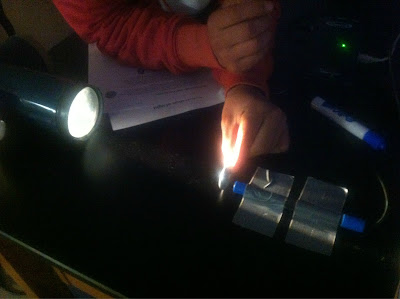The purpose of this experiment was to explore the relationship between the light intensity transmitted through two polarizing filters and the angle between the filter axes; through three polarizers; and polarization upon reflection.
Preliminary questions:
1. The light intensity is decreasing until it becomes dark finally at the right angle.
2. The light intensity is decreasing until it becomes dark and then starts increasing to become very bright.
Experiment
0 degree was marked
Two polarizers
Roatate the analyzer by 10 degree increasement clockwisely and counterclockwisely
with three polarizers
Data Two polarizers
Angle
(degree)
|
Intensity
(clockwise)
(lux)
|
Intensity (counterclockwise)
(lux)
|
Average
(lux)
|
I/Imax
|
cos(theta)^2
|
0
|
204
|
208
|
206
|
1
|
1
|
10
|
201
|
198
|
199.5
|
0.97
|
0.97
|
20
|
189
|
182
|
185.5
|
0.90
|
0.88
|
30
|
172
|
163
|
167.5
|
0.81
|
0.75
|
40
|
150
|
146
|
148
|
0.72
|
0.59
|
50
|
115
|
113
|
114
|
0.56
|
0.41
|
60
|
97
|
87
|
92
|
0.45
|
0.25
|
70
|
83
|
75
|
79
|
0.38
|
0.12
|
80
|
67
|
63
|
65
|
0.32
|
0.03
|
90
|
59
|
57
|
58
|
0.28
|
3.8E-33
|
Analysis
1.
The light intensity decreases as the angle increases with maximum intensity at 0 degree (the light after the first polarizer is parallel to the polarized axis of the second polarizer) and minimum intensity at 90 degree because only the light that is parallel to the polarized axis can pass through.
2.
3.
4. If two polarizers are oriented perpendicular to each other, then the intensity observed will be zero because only light that are parallel to the axis of the polarizer can pass through (cos90=0). Therefore, if two polarizers are oriented parallel to each other(cos0=1), then the intesity observed will be the maximum. If there is an angle between the two polarizers, partial amount of light can pass through.
Data
Three polarizers
Angle
(degree)
|
intensity
(clockwise)
(lux)
|
cos^2
|
0
|
50
|
1
|
10
|
49
|
0.97
|
20
|
52
|
0.88
|
30
|
58
|
0.75
|
40
|
62
|
0.59
|
50
|
62
|
0.41
|
60
|
58
|
0.25
|
70
|
54
|
0.12
|
80
|
50
|
0.03
|
90
|
48
|
3.8E-33
|
Analysis
1&2.
3.
4. The center of axis of the first polarizer is 0 and 90 for the third polarizers. If the second polarizer is on its 0 or 90, the light intensity will be the minimum. If the second polarizer is at 45 orientation, then the intensity observed will be the maximum.
Polarization upon reflection
1. No, the light from the fluorecent bulb is unpolarized. It has the light oriented in all directions.
2. The light in the plane that is perpendicular to the table is polarized.
Conclusion
This experiment proved the formula of polarization, I=I_0*cos^2(theta), where theta is the angle difference between the polarized axises of the polarizers. Therefore, for two polarizers, if their polarized axises are perpendicular to each other, 0 intensity is observed, and maximum intensity are observed if their polarized axises are parallel to each other. For three polarizers, the maximum intensity occus when the polarized axis of the central polarizer is 45 degree, and the observed intensity depends on the angle differences between the polarized axises of polarizer 1 and 2, and 2 and 3.
I0*cos(theta)^2*cos(pi/2- theta)^2
I0*cos(theta)^2*sin(theta)^2
1/4 I0*sin(2*theta)^2
when theta= 45, it reaches the maximum value.
This angle matches with the experimental data and the graph.
This angle matches with the experimental data and the graph.
Polarization upon reflection
1. No, the light from the fluorecent bulb is unpolarized. It has the light oriented in all directions.
2. The light in the plane that is perpendicular to the table is polarized.
Conclusion
This experiment proved the formula of polarization, I=I_0*cos^2(theta), where theta is the angle difference between the polarized axises of the polarizers. Therefore, for two polarizers, if their polarized axises are perpendicular to each other, 0 intensity is observed, and maximum intensity are observed if their polarized axises are parallel to each other. For three polarizers, the maximum intensity occus when the polarized axis of the central polarizer is 45 degree, and the observed intensity depends on the angle differences between the polarized axises of polarizer 1 and 2, and 2 and 3.









No comments:
Post a Comment